Garden & Plants / Plants that grow well at Earlscliffe / Picture Gallery / 4 year pictorial study of plants / Plants in 2001
Previous / Next: Plants in 2000 / Plants in 2002
Previous 'Plants of the month' 2001
Plant of the month for December, 2001
Since May 2000 I have photographed a plant at Earlscliffe towards the end of each month as the plant for the following month. Logically each plant should be photographed in the month to which it is attributed. This will be the policy from now on so that there will be two plants for December 2001,
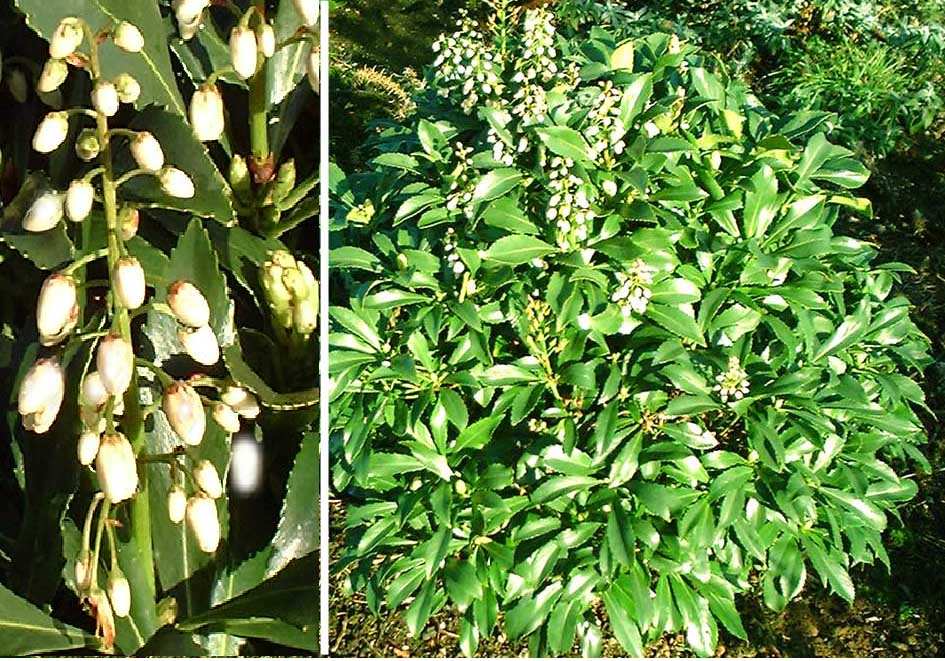 Acer
palmatum 'Osakazuki' photographed in November and Anopterus glandulosus
photographed in December.
Acer
palmatum 'Osakazuki' photographed in November and Anopterus glandulosus
photographed in December.
Anopterus glandulosus from Tasmanium woodlands survived - 7º C in the 2000/2001 winter and produced beautiful spikes of pure white terminal flowers in December 2001. Although reputed to be rather fastidious, this young plant is growing well at Earlscliffe in an open, sunny situation exposed to south easterly wind without any sign of low temperature or wind injury.
Plant of the month for December 2001
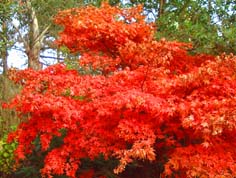 After
a good growing season, the autumn was relatively frost free, moist, calm and
warm. Conditions were ideal for autumn colour and many genera, such as
Magnolia, Betula and Gingko, gave exceptionally colourful
displays. Most flamboyant of all was Acer palmatum septemlobum
'Osakazuki', photographed on November 18, 2001, with its brilliant vivid scarlet
leaves which lasted for several weeks. .
After
a good growing season, the autumn was relatively frost free, moist, calm and
warm. Conditions were ideal for autumn colour and many genera, such as
Magnolia, Betula and Gingko, gave exceptionally colourful
displays. Most flamboyant of all was Acer palmatum septemlobum
'Osakazuki', photographed on November 18, 2001, with its brilliant vivid scarlet
leaves which lasted for several weeks. .
Plant of the month for November 2001
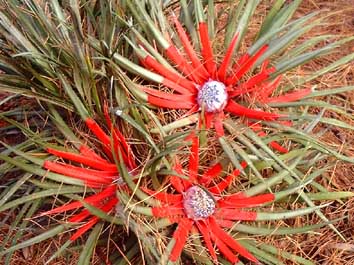 Fascicularia
bicolor, from central and southern Chile, makes a long lasting show in
the autumn when the base of the leaves surrounding the blue flowers turns a
bright crimson. This Bromeliad is exceptionally hardy under conditions here and
has never shown any signs of winter injury since first planted 32 years ago. The
plant is easy to propagate as offsets pushed into the soil root readily.
Fascicularia
bicolor, from central and southern Chile, makes a long lasting show in
the autumn when the base of the leaves surrounding the blue flowers turns a
bright crimson. This Bromeliad is exceptionally hardy under conditions here and
has never shown any signs of winter injury since first planted 32 years ago. The
plant is easy to propagate as offsets pushed into the soil root readily.
Plant of the month
for October 2001
Aloysia citriodora, Lemon Verbena (formerly Lippia citriodora) is a late starter. It confuses many people by appearing dead until late spring but then once it gets going it continues to grow and flowers profusely into late autumn. The flowers are small, white and not very conspicuous, but the plant's claim to flame is not its flowers or architectural beauty but the intense fragrance of its leaves. Although often used as bedding, this Aloysia is now a tree 4 metres high, growing strongly and has more strongly scented foliage than any other plant in the garden.
Plant of the month for September 2001
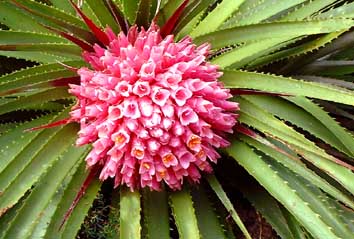 Ochagavia
carnea, a typical bromeliad from the coastal area of central Chile, helps
to brighten up the autumn garden with its large inflorescence of bright rose
pink flowers. According to the New Royal Horticultural Society Dictionary of
Gardening, Ochagavia carnea is a Climatic Zone 10 plant. This clearly needs
modification to Climatic Zone 9 in the next edition for many plants in
different part of the garden have withstood - 7º C in the 2000/01 winter and a
slightly lower temperature in 1995/96 without the slightest sign of injury.
Ochagavia
carnea, a typical bromeliad from the coastal area of central Chile, helps
to brighten up the autumn garden with its large inflorescence of bright rose
pink flowers. According to the New Royal Horticultural Society Dictionary of
Gardening, Ochagavia carnea is a Climatic Zone 10 plant. This clearly needs
modification to Climatic Zone 9 in the next edition for many plants in
different part of the garden have withstood - 7º C in the 2000/01 winter and a
slightly lower temperature in 1995/96 without the slightest sign of injury.
Plant of the month - August 2001
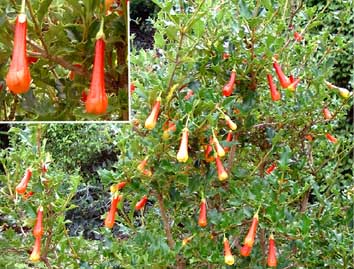 Desfontainia
spinosa is a native of the Andes from Colombia to the Straits of Magellan.
It has holly-like evergreen foliage and tubular flowers. These may be scarlet
with a yellow tip or all scarlet as in the inset. The plant is reputed to grow
better in Scotland and Northern Ireland than in the south west of England and to
need constant shade at the roots. This specimen is growing in an open situation
without shade at the roots but being near the sea it is seldom exposed to
temperatures in excess of 23 degrees C. The plant is a survivor having been run
over twice by a tractor in the course of building operations with no lasting
damage. It also came through the severe 2000/01 winter without injury.
Desfontainia
spinosa is a native of the Andes from Colombia to the Straits of Magellan.
It has holly-like evergreen foliage and tubular flowers. These may be scarlet
with a yellow tip or all scarlet as in the inset. The plant is reputed to grow
better in Scotland and Northern Ireland than in the south west of England and to
need constant shade at the roots. This specimen is growing in an open situation
without shade at the roots but being near the sea it is seldom exposed to
temperatures in excess of 23 degrees C. The plant is a survivor having been run
over twice by a tractor in the course of building operations with no lasting
damage. It also came through the severe 2000/01 winter without injury.
Plant of the month - July 2001
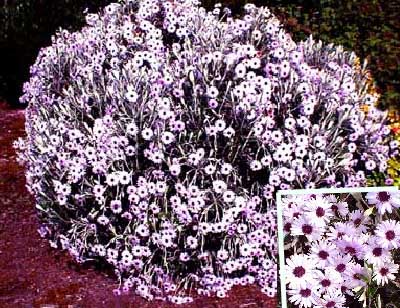 A
six year old plant of Olearia 'Henry Travers'. This plant was
introduced to Ireland as O. semidentata in 1908 but is now believed to
be a hybrid between O. semidentata and the coarser O.chathamica.
Olearia 'Henry Travers' , with its pale purple ray florets and dark
purple disc florets is the most beautiful Olearia that grows here. The flowers
become larger and paler with age. This plant is growing near the sea and is
fully exposed to south easterly gales. It has never been fed, watered or pruned.
Pampered plants flower poorly and often die an early death. Plants given benign
neglect can live for over 30 years and grow to a height of 3.5 - 4 metres.
A
six year old plant of Olearia 'Henry Travers'. This plant was
introduced to Ireland as O. semidentata in 1908 but is now believed to
be a hybrid between O. semidentata and the coarser O.chathamica.
Olearia 'Henry Travers' , with its pale purple ray florets and dark
purple disc florets is the most beautiful Olearia that grows here. The flowers
become larger and paler with age. This plant is growing near the sea and is
fully exposed to south easterly gales. It has never been fed, watered or pruned.
Pampered plants flower poorly and often die an early death. Plants given benign
neglect can live for over 30 years and grow to a height of 3.5 - 4 metres.
Plant of the month - June 2001
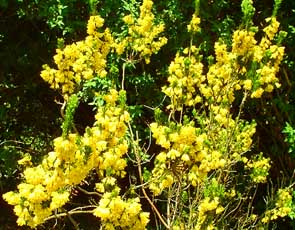 Erica
pageana is one of very few yellow flowered species of heather. It normally
flowers in April but is late this year on account of the severe winter. It is
fairly resistant to low temperatures but appears to be sensitive to summer
drought. In its native South Africa it occurs naturally in marshy places.
Erica pageana is worth growing here for its intensely bright yellow flowers
and for its slight fragrance, but its scent may not appeal to everybody. Not
normally a long lived plant, this specimen is not over 10 years old and is
probably getting towards the end of its natural life.
Erica
pageana is one of very few yellow flowered species of heather. It normally
flowers in April but is late this year on account of the severe winter. It is
fairly resistant to low temperatures but appears to be sensitive to summer
drought. In its native South Africa it occurs naturally in marshy places.
Erica pageana is worth growing here for its intensely bright yellow flowers
and for its slight fragrance, but its scent may not appeal to everybody. Not
normally a long lived plant, this specimen is not over 10 years old and is
probably getting towards the end of its natural life.
Plant of the month - May 2001
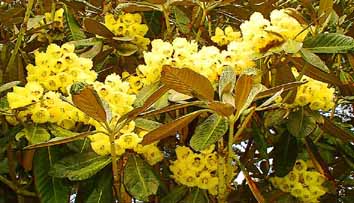 This
specimen of Rhododendron macabeanum x sinogrande is a
natural hybrid from the island of Ilnacullin, West Cork. Planted as a seedling
in 1975, it has now formed a small tree about 5.5 metres high and is the largest
rhododendron at Earlscliffe. The vigorous growth is surprising as our average
rainfall is only 660 mm and no additional water is provided. The plant is
probably favoured by the low summer temperature which seldom exceeds 23° C. R.
macabeanum x sinogrande is attractive all year with its striking large,
leathery leaves and its huge trusses of yellow flowers in April and May. Despite
the harsh winter, the plant has flowered well this spring although much later
than normal.
This
specimen of Rhododendron macabeanum x sinogrande is a
natural hybrid from the island of Ilnacullin, West Cork. Planted as a seedling
in 1975, it has now formed a small tree about 5.5 metres high and is the largest
rhododendron at Earlscliffe. The vigorous growth is surprising as our average
rainfall is only 660 mm and no additional water is provided. The plant is
probably favoured by the low summer temperature which seldom exceeds 23° C. R.
macabeanum x sinogrande is attractive all year with its striking large,
leathery leaves and its huge trusses of yellow flowers in April and May. Despite
the harsh winter, the plant has flowered well this spring although much later
than normal.
Plant of the month (April 2001)
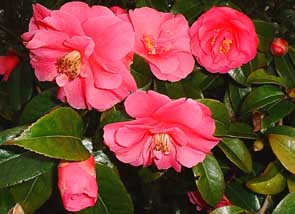 Camellia
'Inspiration' (C. reticulata wild form x C. saluensis) and other
Camellia varieties are helping to bring back some bright colour to a garden set
back by the harshest winter in at least 31 years. 'Inspiration' is selected as
the Plant for April because the flowers are more weather proof than 12 other
varieties grown. In almost every year 'Inspiration' will open its first flowers
between Christmas Day and New Year's Eve and flowering continues until mid-May.
Flowering has been delayed this season because of the cold winter.
Camellia
'Inspiration' (C. reticulata wild form x C. saluensis) and other
Camellia varieties are helping to bring back some bright colour to a garden set
back by the harshest winter in at least 31 years. 'Inspiration' is selected as
the Plant for April because the flowers are more weather proof than 12 other
varieties grown. In almost every year 'Inspiration' will open its first flowers
between Christmas Day and New Year's Eve and flowering continues until mid-May.
Flowering has been delayed this season because of the cold winter.
In the meantime, many of the Zone 9 plants that have been severely damaged by low temperatures and appeared dead until late March, such as Sonchus arboreus and Tetrapanax papyrifer, are beginning to show signs of recovery.
Plant of the month (March 2001)
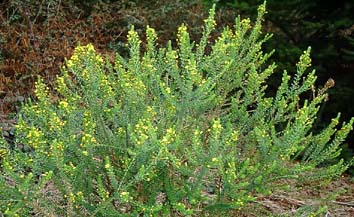 Euryops
virgineus from South Africa is selected this month, not because of it
flamboyance but because it has flowered continuously from before Christmas to
well into March (at least), through the most severe spell of weather since
records began here in 1969. The plant in an open, unprotected situation has
survived temperatures as low as -7º C without damage. Rated as Climatic Zone 9,
Euryops virgineus has come through the winter in better condition than
E.pectinatus (rated Zone 8) which was slightly damaged and also E.
chrysanthemoides (rated Zone 9) which appears at present to have been
killed by the low temperature between December 26 and 30, 2000.
Euryops
virgineus from South Africa is selected this month, not because of it
flamboyance but because it has flowered continuously from before Christmas to
well into March (at least), through the most severe spell of weather since
records began here in 1969. The plant in an open, unprotected situation has
survived temperatures as low as -7º C without damage. Rated as Climatic Zone 9,
Euryops virgineus has come through the winter in better condition than
E.pectinatus (rated Zone 8) which was slightly damaged and also E.
chrysanthemoides (rated Zone 9) which appears at present to have been
killed by the low temperature between December 26 and 30, 2000.
Plant of the month (February 2001)
As expected the recent spell of severe weather killed many of the most tender plants in the garden including Erica x hiemalis, the heather selected as plant of the month for January 2001. The same plant in its moribund condition has been selected for February 2001 as a memento mori and in memory of the many other plants that have died at the same time. These include Aeonium tabuliforme, Aloe arborescens, Erica doliiformis, Psoralea affinis and many others.
This cold spell is a benefit rather than a disadvantage as it provides useful information on plant hardiness and also on the extent to which many apparently dead plants such as Brugmansia sanguinea and Metrosideros excelsus will recover. At least one plant, listed as Climatic Zone 10 (Tropical) in the New RHS Dictionary of Gardening, Tetraclinis articulata has survived apparently unscathed. Big differences in low temperature tolerance of species within genera such as Agave and Aloe are already obvious and will be recorded later in the year. Many interesting plants including the palm Juania australis and Protea species have survived to provide continuing interest in the garden.
Plant of the month (February 2001) Plant of the month (January 2001)
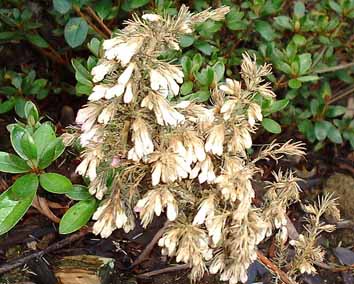
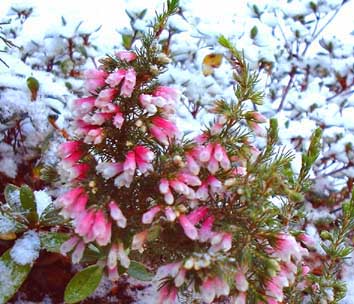 Erica
x hiemalis flowering during an exceptionally cold spell (down to -7°C) just
before New Year's Day 2001. This is an ill defined species of unknown origin.
The name is often given to collate hybrids raised in Britain, France and
Germany. Erica x hiemalis produces racemes of rose tinted flowers in
mid-winter and brings a touch of colour to the garden in December/January.
Erica
x hiemalis flowering during an exceptionally cold spell (down to -7°C) just
before New Year's Day 2001. This is an ill defined species of unknown origin.
The name is often given to collate hybrids raised in Britain, France and
Germany. Erica x hiemalis produces racemes of rose tinted flowers in
mid-winter and brings a touch of colour to the garden in December/January.
The weather in the last week in December 2000 has surpassed all previous records for low temperatures, with -6, -4, -7 and - 5.5°C being recorded on successive nights from the 26th to the 29th. It is inevitable that there will be considerable loss of more tender (Zone 9) plants in the early months of 2001.
Plant Collections
For more details of the plants that grow at Earlscliffe, see the following pages
This page was last updated on 27-Jul-2023 .
